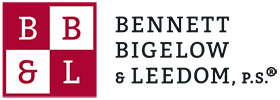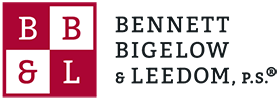On March 21, 2019, the State Supreme Court, en banc, issued L.M. v. Hamilton, 193 Wn.2d 113, 436 P.3d 803 (2019), addressing two requirements for the admission of expert testimony: (1) compliance with the Frye requirement that the expert’s testimony be based on generally accepted scientific principles and methodologies; and (2) ER 702’s requirement that the testimony come from a qualified expert and will help the lay jury.
In this medical negligence claim arising from a brachial plexus birth injury, the Court concluded the trial court did not err in admitting the defendant midwife’s medical experts’ and biomedical engineer’s testimony under Frye, infra, and ER 702.
- Factual and procedural background.
In April 2010, the defendant midwife delivered L.M. Over the first few months of his life, L.M. experienced complete paralysis of his upper arm and weakness in the other portion. Exploratory surgery revealed substantial injuries to the child’s brachial plexus.[1] L.M.’s brachial plexus injury was most likely permanent because all five of his brachial nerve roots were injured. The child has limited use of his arm and still experiences pain.
L.M., through a guardian, filed suit against the midwife, alleging she responded negligently to L.M.’s shoulder dystocia by applying excessive force. The plaintiff alleged that only excessive force, and not the natural forces of labor (NFOL), could have caused the type of damage to the brachial plexus nerves suffered by L.M. At trial, the plaintiff unsuccessfully (after reconsideration) moved to exclude the testimony of several of the midwife’s experts, who opined that L.M.’s injuries were caused by the NFOL. One of these experts was biomechanical engineer, Allan Tencer. The jury found for the defendant midwife, which was later affirmed by Division I of the Court of Appeals.[2] L.M. sought review by the Supreme Court on multiple grounds, including the trial court allowing admission of the mid-wife’s experts’ opinions that L.M.’s injuries could have been caused by NFOL. The Supreme Court accepted review.
- Frye does not require that every deduction drawn from generally accepted medical theories to be generally accepted in order to be admissible.
Washington courts adhere to the standard for the admissibility of expert opinions set forth in Frye v. United States, 293 F. 1013 (D.C. Cir. 1923), which requires that expert witnesses base their opinions on generally accepted science. As developed by the State Supreme Court, the Frye test requires that the relevant scientific community “must generally accept both the underlying theory, and the techniques, experiments, or studies applying that theory.” L.M., 193 Wn.2d at 128 (citation and internal quotations omitted).
The Court affirmed the trial court’s conclusion that the midwife’s medical causation experts could testify that NFOL could have caused the child’s brachial plexus injuries. The Court held Frye requires only that the midwife’s experts draw a deduction from generally accepted science, not that specific causation theories are generally accepted. Because the specific types of injuries sustained by L.M. are a type of permanent injury, and it was undisputed that the literature establishes that NFOL can cause permanent brachial plexus injuries, the midwife’s experts’ deductions were based on generally accepted scientific principles. Id. at 130-31.
The Court reasoned that “[r]equiring general acceptance of each discrete and ever more specific part of an expert opinion would place virtually all opinions based upon scientific data into some part of the scientific twilight zone.” Id. at 131 (citation and internal quotations omitted).
- Admission of expert causation testimony from a biomechanical engineer was not an abuse of discretion, even if it was a “close call.”
The Court also concluded that the admission of testimony from Allan Tencer, a biomechanical engineer, was not an abuse of discretion by the trial court. Assuming Frye was not applicable, expert testimony must meet the threshold standard under ER 702 to be admissible: (1) the witness qualifies as an expert; and (2) the testimony will assist the trier of fact.
The Court concluded the testimony of Dr. Tencer met both requirements of ER 702. The Court acknowledged that Dr. Tencer does not have “remarkable experience” in the biomechanics of childbirth. It noted, however, that ER 702 states that an expert may testify based on their “knowledge, skill, experience, training or education.” Id. at 136-37 (emphasis in original). Further, Dr. Tencer was highly qualified to testify about biomechanical forces in general and had personally studied the spine. Id. at 137. Although it was “a close call”, the Court held that it was not an abuse of discretion for the trial court to conclude Dr. Tencer was qualified as an expert.
Dr. Tencer’s testimony also met the second requirement under ER 702 when quantifying the forces of labor, which the Court found is “obviously outside the competence of an ordinary layperson.” Id. at 138. Dr. Tencer concluded it was not possible to differentiate whether L.M.’s injuries were caused by an exogenous, endogenous, or some combination of both forces. Despite Dr. Tencer’s concession that the force necessary to injure the brachial plexus is not known and cannot be known, the current literature establishes that NFOL can cause permanent injury to those nerves. Id.
The Court also acknowledged, as did the trial court, that because of ethical concerns, it was largely “impossible” to know how much force is necessary to cause such an injury. Id. Based on this, the Court could not say the trial court’s ruling that Dr. Tencer’s testimony could help the lay jury was manifestly unreasonable. Id.
- Impact and import of L.M.’s holding.
The Court’s opinion in L.M. is the latest in a long line of Washington jurisprudence recognizing the broad discretion maintained by the trial court in determining the admissibility of expert testimony under both Frye and ER 702. Its holding regarding the narrow circumstances in which Frye is implicated builds upon its previous opinion in Anderson v. Akzo Nobel Coatings, Inc., 172 Wn.2d 593, 609, 260 P.3d 857 (2011), where the Court held that Frye does not require that the general scientific community accepts the expert’s specific causation theory.
Further, the Court affirming the admissibility of Dr. Tencer’s biomechanical opinions to this birth-injury case even more clearly demonstrates the broad discretion afforded to the trial court on such issues. It also demonstrates the substantial hurdle on appeal under the abuse of discretion standard of care review when challenging the admissibility of evidence.
If you have additional questions regarding this decision, please contact attorney David Norman. 206-622-5511 or dnorman@bbllaw.com.
[1] The brachial plexus is a network (plexus) of nerves (formed by the anterior rami of the lower four cervical nerves and first thoracic nerve (C5, C6, C7, C8, and T1).
[2] 200 Wn. App. 535, 402 P.3d 870 (2018).

